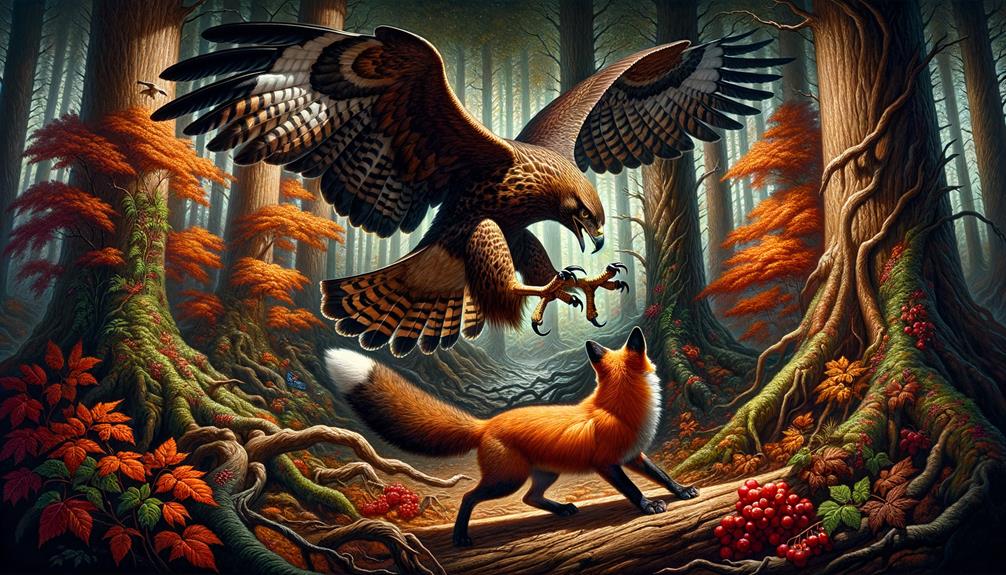Territoriality and aggression displays are vital for many animal species, helping them protect their resources and increase their chances of reproducing. During breeding season, these displays become more intense, often starting with posturing and escalating to vocalizations or even physical confrontations. Research has shown that higher levels of DHEA can increase aggression, influenced by the availability of resources and habitat conditions. These behaviors aren't just about securing resources; they're also about evaluating an opponent's strength and maintaining dominance. Social context plays a significant role, with animals exhibiting greater aggression towards larger species or intruders of the same kind. The complex interplay of these factors is fascinating, and understanding them can provide valuable insights.
Key Takeaways
Territorial aggression reaches its peak during the breeding season, as animals fight to secure mating opportunities and defend their territory. When intruders approach, animals often issue visual and vocal warnings to deter them without resorting to physical confrontation. Research has shown that higher levels of DHEA are linked to increased aggression in territorial animals. The availability of resources in the environment also plays a significant role in shaping the intensity and frequency of aggressive behaviors. Additionally, interactions with other species can escalate aggression, particularly towards smaller or competing species.
Factors Influencing Aggression
Over time, researchers have identified various environmental, biological, and social factors that influence aggression. One key factor that stands out is territorial aggression, particularly during breeding season. Animals exhibit territorial displays to ward off intruders and secure mating opportunities. These behaviors aren't random; they spike in aggression levels precisely when breeding season rolls around.
I've observed how simulated territorial intrusion can trigger intense aggressive encounters. By mimicking an invader, animals react fiercely to protect their space. This isn't just about physical fights; it often involves displays that signal strength and deter potential threats without direct confrontation.
DHEA levels play a significant role in fueling territorial behavior. Higher DHEA levels correlate with increased aggression, particularly in the context of defending territory. Environmental factors, such as resource availability and habitat conditions, also influence these behaviors.
Understanding these dynamics allows us to appreciate the underlying mechanisms driving aggressive behavior. It's not just about competition; it's a survival strategy deeply ingrained in the animal kingdom. By analyzing these factors, we gain insights into the complexities of territorial aggression and its pivotal role in animal behavior.
Resource Defense Strategies

Territorial aggression extends into resource defense, where animals use a range of aggressive displays to secure essential resources like food, shelter, and mates. These aggressive behaviors vary from vocalizations and visual signals to physical attacks. The specific displays an animal uses depend on its body size, weaponry, and social dominance, as well as the perceived threat level of the intruder.
When defending resources, animals often follow a sequence of escalation:
- Initial warnings – They start with posturing and threat displays to assess the opponent's resource holding potential (RHP).
- Increased threats – If initial warnings are ineffective, animals may engage in more pronounced vocalizations or close-range visual displays.
- Physical confrontations – If escalation continues, it can lead to physical aggression, which carries a significant risk of injury.
- Assessing the opponent – Animals frequently assess the RHP of their opponent and decide whether to escalate based on their chances of winning.
Successfully defending resources can significantly improve an animal's fitness, ensuring access to crucial resources. On the other hand, failure in resource defense can lead to the loss of these resources and potential injury or death. This delicate balance of aggression, social dominance, and the risk of injury shapes the strategies animals use for resource defense.
Social Context Effects

Aggressive displays in animals are heavily influenced by their social context, particularly the presence and mix of other species nearby. When these audiences are more diverse or feature larger-bodied species, territorial aggression intensifies. For example, tufted titmice exhibit heightened aggression towards Carolina chickadees, mainly driven by body size, despite both species being capable of inflicting serious harm on each other.
In a socially complex environment with multiple species, the presence of a diverse audience amplifies the intensity of territorial displays. Tufted titmice and Carolina chickadees show peak aggression when dealing with intruders of the same species, highlighting the priority of defending their own territory over interactions with other species. This behavior shows how the diversity of species and audience composition can impact aggression levels.
Controlled studies, which account for factors like tree density and noise level, reveal that social context has a significant impact on territorial aggression. Larger-bodied species tend to dominate smaller ones, shaping the dynamics of interspecies interactions. By understanding how social context and heterospecific audiences affect aggressive behavior, we can better grasp the complexities of multi-species interaction networks and territorial defense.
Interspecific Interactions

How do interspecies dynamics shape the intensity and nature of territorial aggression displays among animals? Interspecific interactions greatly influence how animals engage in territorial aggression. Aggressive behavior isn't just directed at conspecifics; many social animals also show aggressive displays toward other species. For example, tufted titmice exhibit more aggression toward smaller Carolina chickadees than chickadees do toward them, highlighting that size and perceived threat can dictate the intensity of aggressive encounters.
The presence and diversity of bystander species also impact territorial aggression. In the presence of larger or more diverse audiences, aggression between competing conspecifics can escalate. Interspecific interactions affect aggression in the following ways:
- Larger audiences of different species increase aggression levels.
- A diverse set of bystander species intensifies aggression.
- Some species, like titmice, are more aggressive toward smaller species.
- Aggression can vary depending on the specific interspecies dynamics at play in different contexts.
Research on aggression reveals that social behavior and territorial aggression are closely linked. Understanding these interspecific interactions provides valuable insights into the complex social behaviors driving aggressive displays and territorial defense.
Behavioral Adaptations

Animals develop behavioral adaptations to help them survive and reproduce in competitive environments. Take male song sparrows, for example. During the breeding season, they become territorial and aggressive, using visual displays and songs to defend their territory. When faced with a simulated territorial intrusion, these sparrows intensify their aggression to maintain their status as territory holders.
Aggression in birds changes with the seasons. During the breeding season, aggression peaks as males compete for mates and defend nesting sites. Even in the non-breeding season, some species maintain a level of aggression to protect valuable resources like food and shelter.
| Behavior | Season | Purpose |
|---|---|---|
| Song | Breeding | Attract mates |
| Visual Displays | Year-round | Assert dominance |
| Aggression | Breeding | Defend territory |
| Non-breeding Aggression | Non-breeding | Secure food and shelter |
These behavioral adaptations are crucial for reproductive success. By understanding the intricacies of these behaviors, we can appreciate the delicate balance of life in the wild. Territoriality and aggression are not random acts; they are finely tuned responses to the challenges of nature.
Male song sparrows, for instance, use their songs to attract mates and defend their territory. This aggressive behavior is essential for maintaining their status as territory holders. In the non-breeding season, they may tone down their aggression, but still maintain a level of vigilance to protect their resources. This fine-tuned response to the environment helps them survive and reproduce.
Frequently Asked Questions
What Is an Example of Territorial Aggression?
An example of territorial aggression is when male fallow deer clash head-on during the mating season. They use their antlers to fight and establish dominance, ensuring they get to mate by fending off rivals.
What Is a Territorial Display?
Imagine a warrior guarding its fortress. A territorial display is when an animal defends its territory by sending out visual signals, making sounds, or taking physical action to show dominance and exclusive access to vital resources like food and shelter.
What Is an Example of an Animal That Exhibits Territoriality?
Male elephant seals are a prime example of animals that exhibit territoriality. During breeding season, they engage in fierce battles with rivals to gain access to females, showcasing their aggressive nature as they fight to secure their territory.
What Animals Exhibit Territorial Behavior?
Wolves, lions, eagles, and lizards are just a few examples of animals that exhibit territorial behavior. They defend their resources using a range of strategies, from vocalizations and displays to combat. Each species has its own unique approach, highlighting the intricate balance and drive for survival in the natural world.



